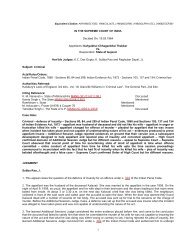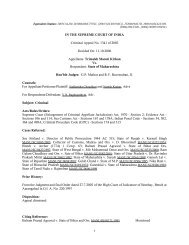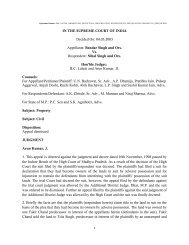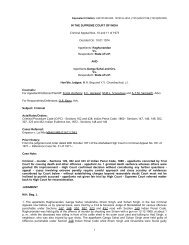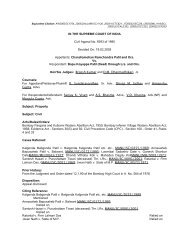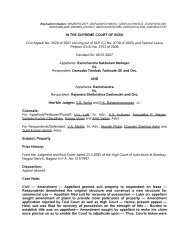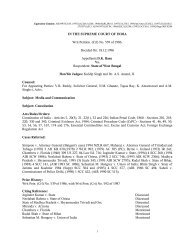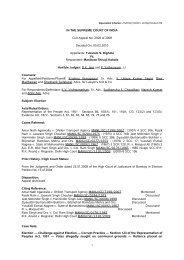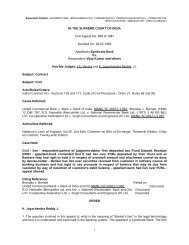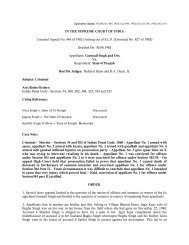IN THE SUPREME COURT OF INDIA Decided On - Judicial ...
IN THE SUPREME COURT OF INDIA Decided On - Judicial ...
IN THE SUPREME COURT OF INDIA Decided On - Judicial ...
You also want an ePaper? Increase the reach of your titles
YUMPU automatically turns print PDFs into web optimized ePapers that Google loves.
12. These observations received the approval of this Court in Palvinder Kaur v. The State of Punjab<br />
MANU/SC/0038/1952 : 1953CriLJ154 . In State of U. P. v. Deoman Upadhyaya (6) MANU/SC/0060/1960 :<br />
1960CriLJ1504 , Shah, J. referred to a confession as a statement made by a person stating or suggesting the<br />
inference that he has committed a crime.<br />
13. Shortly put, a confession may be defined as an admission of the offence by a person charged with the offence. A<br />
statement which contains self- exculpatory matter cannot amount to a confession, if the exculpatory statement is of<br />
some fact which, if true, would negative the offence alleged to be confessed. If an admission of an accused is to be<br />
used against him, the whole of it should be tendered in evidence, and if part of the admission is exculpatory and part<br />
inculpatory, the prosecution is not at liberty to use in evidence the inculpatory part only. See Hanumant v. State of U.<br />
P. (1) MANU/SC/0037/1952 : 1953CriLJ129 and Palvinder Kaur v. The State of Punjab [1953] S. C 94. The<br />
accused is entitled to insist that the entire admission including the exculpatory part must be tendered in evidence. But<br />
this principle is of no assistance to the accused where no part of his statement is self-exculpatory, and the<br />
prosecution intends to use the whole of the statement against the accused.<br />
14. Now, a confession may consist of several parts and ma reveal not only the actual commission of the crime but<br />
also the motive, the preparation, the opportunity, the provocation, the weapons used, the intention, the concealment<br />
of the weapon and the subsequent conduct of the accused. If the confession is tainted, the taint attaches to each part<br />
of it. It is not permissible in law to separate one part and to admit it in evidence as a non-confessional statement.<br />
Each part discloses some incriminating fact, i.e., some fact which by itself or along with other admitted or proved facts<br />
suggests the inference that the accused committed the crime, and though each part taken singly may not amount to a<br />
confession, each of them being part of a confessional statement partakes of the character of a confession. If a<br />
statement contains an admission of an offence, not only that admission but also every other admission of an<br />
incriminating fact contained in the statement is part of the confession.<br />
15. If proof of the confession is excluded by any provision of law such as s. 24, s. 25 and s. 26 of the Evidence Act,<br />
the entire confessional statement in all its parts including the admissions of minor incriminating facts must also be<br />
excluded, unless proof of it is permitted by some other section such as s. 27 of the Evidence Act. Little substance<br />
and content would be left in ss. 24, 25 and 26 if proof of admissions of incriminating facts in a confessional<br />
statement is permitted.<br />
16. Sometimes, a single sentence in a statement may not amount to a confession at all. Take a case of a person<br />
charged under s. 304-A of the Indian Penal Code and a statement made by him to a police officer that "I was drunk;<br />
I was driving a car at a speed of 80 miles per hour; I could see A on the road at a distance of 80 yards; I did not blow<br />
the horn; I made no attempt to stop the car; the car knocked down A". No single sentence in this statement amounts<br />
to a confession, but the statement read as a whole amounts to a confession of an offence under s. 304-A of the<br />
Indian Penal Code, and it would not be permissible to admit in evidence each sentence separately as a non-<br />
confessional statement. Again, take a case where a single sentence in a statement amounts to an admission of an<br />
offence.'A' states "I struck 'B' with a tangi and hurt him". In consequence of the injury 'B' died.'A' committed an offence<br />
and is chargeable under various sections of the Indian Penal Code. Unless he brings his case within one of the<br />
recognised exceptions, his statement amounts to an admission of an offence, but the other parts of the statement<br />
such as the motive, the preparation, the absence of provocation, concealment of the weapon and the subsequent<br />
conduct, all throw light upon the gravity of the offence and the intention and knowledge of the accused, and negatives<br />
the right of private defence, accident and other possible defences. Each and every admission of an incriminating fact<br />
contained in the confessional statement is part of the confession.<br />
17. If the confession is caused by an inducement, threat or promise as contemplated by s. 24 of the Evidence Act,<br />
the whole of the confession is excluded by s. 24. Proof of not only the admission of the offence but also the<br />
admission of every other incriminating fact such as the motive, the preparation and the subsequent conduct is<br />
excluded by s. 24. To hold that the proof of the admission of other incriminating facts is not barred by s. 24 is to rob<br />
the section of its practical utility and content. It may be suggested that the bar of s. 24 does not apply to the other<br />
admissions, but through receivable in evidence, they are of no weight, as they were caused by inducement, threat or<br />
promise. According to this suggestion, the other admissions are relevant, but are of no value. But we think that on a<br />
plain construction of s. 24, proof of all the admissions of incriminating facts contained in a confessional statement is<br />
excluded by the section. Similarly, ss. 25 and 26 bar not only proof of admissions of an offence by an accused to a<br />
police officer or made by him while in the custody of a police officer but also admissions contained in the confessional<br />
statement of all incriminating facts related to the offence.<br />
18. A little reflection will show that the expression "confession" in ss. 24 to 30 refers to the confessional statement<br />
as a whole including not only the admissions of the offence but also all other admissions of incriminating facts related<br />
to the offence. Section 27 partially lifts the ban imposed by ss. 24, 25 and 26 in respect of so much of the<br />
4



